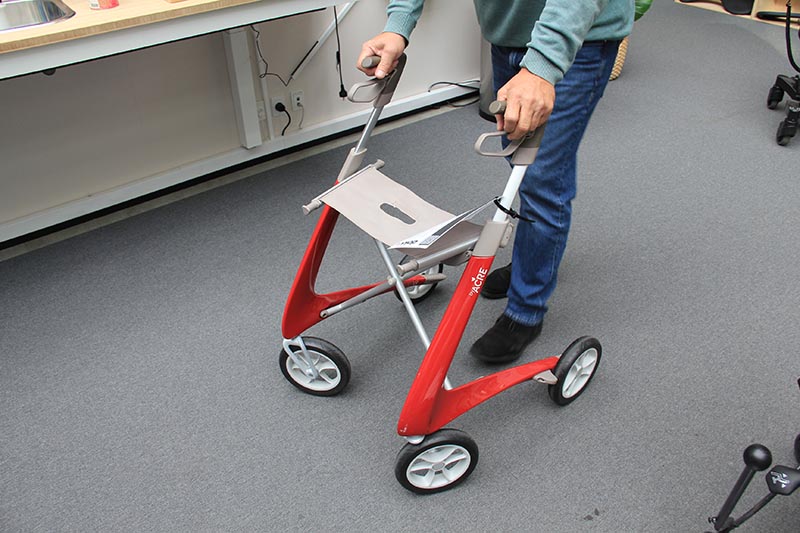These days there has been a dispute within German economic experts: They had drawn up a report on how freight transport can become climate-neutral. In this report, four of the five economic experts call on politicians to develop a nationwide charging infrastructure for electric trucks. Only Veronika Grimm, the fifth expert on this independent committee, broke out of line: She believes that the focus on e-trucks is wrong and that other technologies such as hydrogen-powered fuel cells should also be further promoted.
So what makes sense: A focus on e-mobility in freight transport or a more open approach? And what criteria should be used to take a closer look at drive technologies?
We asked science journalist Jens Schröder, who has been running the podcast “Sag mal, du als Physiker” with the two physicists Johannes Kückens and Michael Büker since 2018.
SBC: The economic experts are arguing about pure electrification – or about technological openness in truck freight transport. Who do you think is right? Veronika Grimm or the four other economic experts?
Schröder: I’m glad that the economic experts are only having this debate about trucks and not about cars as well. Because this story about technological openness is really out of place, because the superiority of electric vehicles in terms of energy consumption is clear. There are still discussions about heavy trucks because the low energy density of batteries has a detrimental effect. But even here, in my opinion, the course has already been set.
Major manufacturers such as MAN have long since decided to stop developing H2 drives. The situation is different for aircraft – as things stand at present, there will be no battery-electric alternative here.
SBC: And the truck issue has really already been decided? Ms. Grimm sees things differently.
Schröder: It’s not as clear-cut for truck traffic as it is for cars. But the direction is clear. And should we as a country really now decide to use taxpayers’ money to fund an H2 filling station network along freeways that costs billions of euros in addition to the e-charging infrastructure? I don’t think that makes sense. And I would agree with the majority of the Council on this.
SBC: Why are some drives not feasible or not useful for certain forms of movement? Why does it not make sense to use e-fuels for a car, for example?
Schröder: Theoretically, of course, many things are feasible, but not always sensible. The three alternatives to the fossil combustion engine are the battery electric, the fuel cell – i.e. the hydrogen drive – and e-fuels. By the way, in a fuel cell, electricity is generated by hydrogen – and then only a normal electric motor is driven.
Many people do not realize that all three of these drive alternatives basically run on electricity. After all, electricity is needed to produce hydrogen, and green and CO2-neutral hydrogen even requires green electricity. Electricity is also the prerequisite for climate-neutral e-fuels, as they are produced on the basis of hydrogen, which is electrolyzed using a large amount of electricity.
>>Electricity is the common currency on which all other drives are based.<<
Converting electricity into hydrogen and then again from hydrogen into e-fuel requires processes with very high energy losses in some cases, which greatly reduces the efficiency of the technologies used. If a battery vehicle travels 100 km, a vehicle with a fuel cell can travel 35 kilometers with the same amount of electricity, and an e-fuel vehicle only 20 kilometers, because so much energy is simply lost as waste heat during the intermediate steps and in the combustion engine. This is a waste based on physical principles that even engineers and inventors cannot invent away.
SBC: Can you go into detail about these processes? How do these figures come about?
Schröder: With e-fuels, the hydrogen on which the e-fuels are then based must be produced first. This would require the energy-intensive extraction of CO2 from the air. It is still an unresolved problem how to do this efficiently, especially if at some point we no longer have sources such as coal-fired power stations etc. where CO2 is found in high concentrations at the chimneys. These are to be gradually switched off.
In the case of e-fuels, it is also often stated as a strength that we could continue to use the normal combustion engines. On the one hand, this is of course a strength, but at the same time it is also a problem, because a combustion engine wastes fuel on principle. An internal combustion engine is a heat engine. Heat is an integral part of the process, converting chemical energy into movement.
A large proportion of the heat dissipates, and the nature of heat is such that it can never be completely converted back. At least 60 % of the energy in a combustion engine is wasted by releasing heat into the environment. Under absolutely ideal conditions, an excellent diesel car achieves 45% efficiency. After the waste of electricity in the production of e-fuels, at least 55% of the energy is wasted during operation. We are talking about laboratory conditions here, in reality around 70 – 75% of the energy is wasted.
It would have been better to drive a battery-powered car. The use of hydrogen or eFuels for cars not only makes no sense in energy terms, it is also a question of availability: The electricity used for the production of these alternative car fuels is not available elsewhere. After all, green electricity will remain a scarce commodity for decades to come.

Jens Schröder is a science journalist, media manager and podcast producer. The former editor-in-chief of GEO (2019 to 2023) has been one of the authors and hosts of the physics podcast “Sag mal, du als Physiker” since 2018. More about him at licennium.de.
SBC: That sounds plausible. In reality, however, we are experiencing a tension between focusing on one technology and openness to technology.
Schröder: And that brings us to the end consumer. I believe that what is now being discussed follows a strategy. It’s “Let’s be open in terms of technology, it’s great for our economy. They can build combustion cars really well, then they can keep building them, because we can refuel them with climate-neutral e-fuels from 2035.”
Yes, sounds good. And theoretically that is also possible. But it won’t work in practice: E-fuels will simply not be available in the necessary quantities. There is an evaluation from the Potsdam Institute. The question is: How many e-fuels will there be worldwide in 2035? The answer is sobering. If ALL the eFuel production facilities announced today are actually built worldwide, then their total global production will cover just 10 percent of the really relevant demand such as aircraft, ships or industry – and ONLY in Germany. Once again: The global production volume, and this is an optimistic estimate, will only cover 10 percent of the non-electrifiable applications of e-fuels IN GERMANY in 2035. And we still haven’t filled up the car.
Now you could say: Okay, maybe there will be a huge boom and e-fuels production will eventually grow to the same extreme as PV systems today. Under this extreme assumption, the global production volume would still only account for 50% of the indispensable demand in Germany. And we still haven’t filled up a car. You don’t really need to say any more than that.
And what will the customers do who have continued to buy combustion engines in the belief that there will be a flood of e-fuels? They will inevitably continue to fill up with diesel or gasoline. Because no government would dare to shut down cars bought in good faith, that would be like expropriation. I believe that this discussion is being driven by people who want to make money from fossil fuels for a few more years.
>> The global production volume, and this is an optimistic estimate, will only cover 10 percent of the non-electrifiable applications of e-fuels IN GERMANY in 2035. And we still haven’t filled up the car.<<
SBC: You mentioned that e-fuels should be used for applications where batteries are not an alternative. Where would that be the case, for example – and why is that?
Schröder: We need e-fuels, they are very important. But we need them where batteries have no chance. Batteries have a comparatively low energy density. Energy density means: How much energy can an energy source store, for example per kilogram. Fossil fuels, or e-fuels, have a very high energy density, around 50 times higher than modern lithium batteries.
There are applications where we need a high energy density. In large passenger aircraft, for example, a battery would have to be heavier than the aircraft itself to provide enough power due to the low energy density. Unrealistic. A great deal of further development would be needed to make purely electric large aircraft possible.
E-kerosene is therefore important for aircraft or for combustion processes in industry, where extreme heat is required that cannot be easily achieved with energy from batteries. You don’t need this energy density in a car, and a lot has happened in the further development of batteries. In the last 4 – 5 years, their energy density has doubled, and it will probably double even further with solid-state batteries. There is still great potential for improvement here.
In the case of trucks, until recently the idea of powering large 40-tonne trucks with hydrogen was being considered. In the meantime, many experts are saying that we would be better off doing this electrically. Above all, e-fuels will simply be in short supply, and we also need hydrogen for other applications. Every liter of e-fuel that is filled into a Ford Escort or VW Touran is much more urgently needed elsewhere – because it cannot be replaced there so easily.
Many e-fuels fans say: We simply produce e-fuels in countries with vast amounts of renewable electricity – in the desert with lots of sunshine or on the windy coasts of Chile. That would be fine in a world where green electricity is available in abundance. But Chile also needs to de-fossilize its economy. And the green electricity that is put into e-fuels for Europe there is simply not available elsewhere in their own country. Apart from the fact that we would also have to transport e-fuels long distances by sea.
SBC: That’s not so green and sustainable.
Schröder: You could say that. And the green electricity is then lacking in these regions. It does matter what I do with this green electricity. You know, the e-fuels fans have been really clever in linking their demands with the term “technology openness”. That sounds so positive for everyone, you can’t have anything against it, but if you think it through to the end, it becomes clear that even a non-determination is harmful at some point.
I believe that citizens should be able to demand that decisions are made in politics. And sometimes that means deciding for one thing and against another when it makes sense to prioritize. Sometimes even against the interests of individual groups. And I often miss that in this discussion.
Also in the discussion about hydrogen drive systems for trucks. This would require the expansion of a hydrogen filling station network. This would cost billions of euros and would only be possible with subsidies. And the question is: Does that really make sense? After all, it is taxpayers’ money.
SBV: So there are tangible interests here, and it is difficult for the end consumer to understand the connections in this multitude of changes. Electricity came from the socket, diesel and gasoline from the pump at the gas station.
Schröder: It was all imported. Now we are also importing, and we would also have to import e-fuels if we upscale them. The main argument for or against a type of drive is efficiency. E-fuels are 5 times less efficient than an electric drive.
SBC: And what about HVO, the biological fuels? Would that be an option?
Schröder: Biological fuels are another matter. We already have them as additives, and now there are also more and more fuels that are made from 100% vegetable oils. For example, from corn, rapeseed or waste fat. They have also recently been approved in Germany.
Many people have fought for their release because these raw materials are renewable. And I also believe that the release of HVO is okay. But I also think that we as a society cannot eat that many chips that are produced with used fat.
With imported vegetable oils, however, we have the problem of palm oil. And if we ourselves were to increase the production of maize or rapeseed as an energy crop, that would be very inefficient. On the same hectare of rapeseed or maize, photovoltaics would produce around 30 times more energy than these energy crops. It would of course depend on the location and orientation, but the output would not even begin to pay off in comparison and without subsidies.
Certainly, in terms of a certain level of self-sufficiency, I think a proportion of biofuels in the mix is a good consideration. But we should certainly not base the transport policy of the future on this.
Thank you for the interview!
Click here for the analysis of the Potsdam Institute for Climate Impact Researchs on e-fuels (only in German)
Image header: Shutterstock
Author: Anja Herberth
Chefredakteurin















